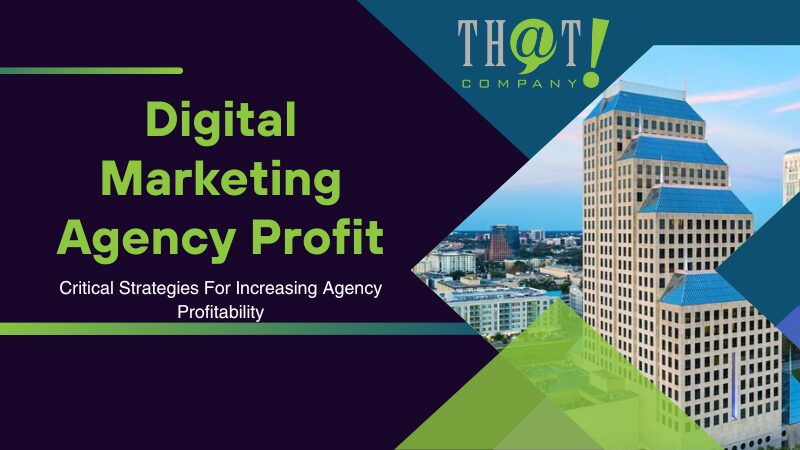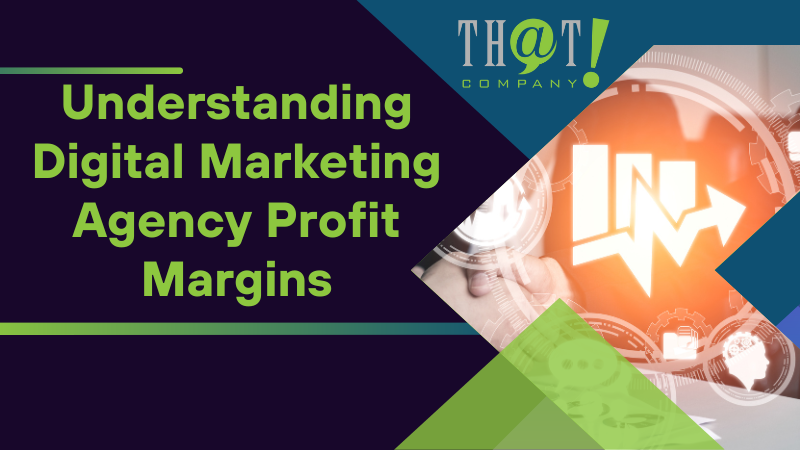
Critical Strategies and Tips For Increasing Agency Profitability
What defines a profitable digital marketing agency? Success hinges on an efficient profit margin. In this article, discover the average digital marketing agency profit margin and find strategies to increase yours. Expect to learn the financial benchmarks for the industry and how to leverage this knowledge for your agency’s growth, without unnecessary jargon or complex explanations.
Essential Insights
Digital marketing agency profit margins, calculated as a percentage of revenue after deducting operational costs, are essential for assessing financial health and comparative profitability. Agencies typically target Delivery Margins over 50% and net profit margins between 20-30%, with high values indicating effective cost and pricing management.
Profit margins are influenced by competition levels, market demand and industry trends. Agencies can sustain profitability by differentiating offerings, adjusting pricing strategies, and staying updated with trends. Operational efficiency and focusing on targeted niche markets are strategic in maintaining high profit margins.
Agencies can optimize profitability without scaling payroll by implementing value-based pricing, refining operational processes, and concentrating on high-value clients. This includes analyzing costs, enhancing productivity, adopting remote work, and providing specialized services to retain loyal clients with high lifetime value.
Table of Contents

Understanding Digital Marketing Agency Profit Margins
The agency profit margin is calculated as the percentage of revenue remaining after subtracting all operational costs. This figure provides insights into the financial performance of a marketing agency. This crucial financial metric serves as a barometer for the health of your agency, indicating how much room there is to withstand downturns, fend off competition, and accommodate potential mistakes.
To maintain healthy profit margins, it is crucial to focus on maintaining a healthy profit margin, which is the key to financial stability and future growth, enabling you to reinvest in your agency and expand its capabilities. It’s a measure of how well your agency can generate profits from its operations, essential for long-term success.
Profit-margin ratios allow for comparisons of profitability between different companies or over time for a single company, highlighting the competitiveness and financial sustainability of your agency in the digital marketing industry.
Gross Profit Margin
The gross profit margin indicates the amount of revenue retained after subtracting the direct costs linked to providing services. It is expressed as a percentage. To calculate the gross profit margin, subtract the direct costs from the revenue, divide the result by the revenue, and then multiply by 100 to express it as a percentage. This method provides a clear understanding of the profitability of a business..
A higher gross profit margin is an indication that your agency is proficiently controlling its direct costs, resulting in a strong profit from its revenue. This signifies effective management of the agency’s finances. In fact, a high-performing digital marketing agency typically targets a Delivery Margin over 50% on the Profit and Loss (P&L) statement, with a margin above this threshold considered indicative of strong efficiency in generating revenue. On the other hand, lower profit margins might suggest a need for improvement in cost management or pricing strategies.
Net Profit Margin
The net profit margin measures the amount of net income derived from revenues after accounting for all operating expenses, interest, taxes, and preferred stock dividends (excluding common stock dividends). This metric is essential in assessing your agency’s financial wellbeing and aiding in future profitability forecasting.
Factors such as the sale of an asset can temporarily influence net profit margins, and operating costs like employee salaries and overhead expenses also play a significant role. In the digital marketing industry, a healthy net profit margin is typically between 20-30% or more on the P&L statement, with anything over 15% being acceptable. It’s important to consider the average profit margin when evaluating the performance of a digital marketing business.

Factors Affecting Profit Margins in Digital Marketing Agencies
Profit margins in digital marketing agencies can be influenced by several factors, including:
Competition
Market demand
Industry trends
The size of the agency
Operational efficiency, reflected in service offerings and overhead control
These elements can play a key role in determining the overall success and profitability of the agency, especially when considering the target audience.
Market demand also plays a crucial role in driving the profitability of digital marketing services. When demand is high, agencies can charge premium rates and achieve higher profitability. However, in saturated or downturn markets, digital marketing agencies may need to:
Adjust their pricing models
Offer discounts or promotions
Provide additional value-added services
Explore new target markets or industries
These strategies can help agencies remain competitive and maintain profitability even in challenging market conditions.
Seasonal fluctuations in market demand can also impact the profit margins of digital marketing agencies, with certain times of the year experiencing higher demand for marketing services. Clearly, market demand significantly influences digital marketing agencies’ ability to set competitive pricing and maximize profit margins.
The level of competition in the digital marketing industry can significantly impact agency profit margins. High competition can lead to price undercutting, reducing profit margins for agencies. Intense competition can also lead to the commoditization of services, forcing agencies to compete primarily on price rather than value or quality.
However, there’s a silver lining. Agencies operating in niche markets with limited competition may enjoy higher profit margins compared to those in highly saturated markets. This highlights the importance of differentiating your agency and its offerings in a competitive digital marketing landscape.
Market demand also plays a crucial role in driving the profitability of digital marketing services. When demand is high, agencies can charge premium rates and achieve higher profitability. However, in saturated or downturn markets, digital marketing agencies may need to:
Adjust their pricing models
Offer discounts or promotions
Provide additional value-added services
Explore new target markets or industries
These strategies can help agencies remain competitive and maintain profitability even in challenging market conditions.
Seasonal fluctuations in market demand can also impact the profit margins of digital marketing agencies, with certain times of the year experiencing higher demand for marketing services. Clearly, market demand significantly influences digital marketing agencies’ ability to set competitive pricing and maximize profit margins.
In the ever-evolving competitive digital marketing industry, staying updated with trends is vital to maintaining healthy profit margins amidst competition. By staying ahead of industry trends, digital marketing agencies can offer innovative services, thereby commanding higher profit margins.
Continuous improvement and keeping versed with current trends and best practices support scalable growth for digital marketing agencies. By adapting to changing industry trends, digital agencies can position themselves as leaders in digital marketing and secure sustainable profit margins for marketing agencies.
Calculating and Analyzing Your Agency's Profit Margins
To reap the benefits of high profit margins, agencies must accurately calculate and analyze their profit margins. This involves:
Determining hourly costs
Estimating operational costs
Assessing overhead costs per hour
Evaluating gross and net margins for clients.
Determining Hourly Costs
Determining hourly costs is a fundamental step in calculating and analyzing your agency’s profit margins. This involves taking into account the total annual cost and available work hours for each team member. Time tracking data is invaluable in this aspect, allowing for accurate recording of billable hours and ensuring fair compensation for the work provided.
Calculating labor costs includes the analysis of hourly revenue targets and historical time tracking data to determine the cost basis for specific services. This approach enables you to set fair and profitable prices for your digital marketing services.
Estimating Operational Costs
Estimating operational costs is another crucial aspect of calculating your agency’s profit margins. These costs typically include expenses like office space rental, technology equipment, and office supplies. Additional overhead costs to consider include accounting, insurance, and continued rent expenses.
Investing in advanced data analytics tools can also affect operational costs. However, these tools are essential for agencies, as they provide insights that can enhance profitability and drive business growth.
Assessing Overhead Costs per Hour
Assessing overhead costs per hour involves considering expenses such as administrative personnel, monthly facility costs, and other non-production related expenses necessary to run the agency. By spreading the cost of administrative staff, such as project managers, across multiple projects, agencies can assess overhead costs more accurately and efficiently.
To determine precise overhead costs per billable hour, agencies implement time tracking for all team members and aggregate this data with monthly operational expenses. This approach ensures a more accurate calculation of overhead costs, allowing for better financial planning and decision-making.
Evaluating Gross and Net Margins for Clients
Evaluating gross and net margins for clients involves subtracting the total hours worked by employees (multiplied by the cost per hour) from the gross sales. This calculation provides an insight into the gross margin for a client. The net margin, on the other hand, is calculated by subtracting the sum of the employee cost per hour and overhead cost per hour from gross sales.
A retainer-based fee structure can help digital marketing agencies in the following ways:
Calculate gross and net margins for clients using various billing methods such as hour-based, deliverables-based, and performance-based approaches
Set clear project scopes and tailored service offerings to allow for setting accurate expectations and prices
Cover costs, including potential revisions and client delays
Strategies to Boost Your Digital Marketing Agency's Profit Margin
Boosting your digital marketing agency’s profit margin requires strategic planning and execution. One such strategy is optimizing operational processes. This involves reducing time and cost expenditure and freeing up resources for more productive tasks, thereby maximizing profitability.
Another effective strategy is the implementation of value-based pricing. By deeply analyzing all costs to identify inefficiencies and adopting value-based pricing, your agency can significantly improve delivery margins. This approach allows you to set prices based on the perceived value of your services to the client, rather than on cost alone.
Focusing on high-value clients is another powerful strategy to boost your agency’s profit margin. High-value clients are those who are loyal and spend more over time, contributing to your agency’s long-term profitability. By understanding these clients’ purchasing history and preferences, and billing every hour worked, you can increase the profit margin associated with specific clients.

How to Increase Your Profit and Scale Your Agency without Scaling Your Payroll
If you’re looking to grow your agency without significantly scaling your payroll, there are several strategies to consider. These include implementing a white label relationship, value-based pricing, optimizing operational processes, and focusing on high-value clients. These strategies are not only effective in maintaining a lean team but also in enhancing the quality of service provided to clients, leading to increased client satisfaction and retention.
-
Using That! Company
- Value-Based Pricing
- Operational Processes
- High-Value Clients
Partnering with a white label service provider like That! Company can be a transformative move for your digital marketing agency. It opens up the possibility of expanding your service offerings to include SEO, PPC, and social media management, without the overhead of hiring additional in-house specialists. This strategic move allows your agency to tap into That! Company’s expertise and resources. You gain access to a team of seasoned professionals who stay on the cutting edge of digital marketing trends and tools, ensuring that your clients receive top-tier services.
That! Company’s white label services are structured with transparent pricing, enabling your agency to mark up and resell these services at a profit. Their comprehensive packages include a variety of options to suit different client needs, from basic SEO packages to more advanced, integrated digital marketing solutions. This flexibility allows you to cater to a broad spectrum of clients, from small businesses to large corporations, increasing your market reach and potential revenue.
Moreover, by leveraging That! Company’s white label services, your agency can scale operations up or down based on client demand, without the risk of scaling your payroll correspondingly. This means you can manage more clients and larger projects with ease, while maintaining a lean operation. The high standard of work delivered under your brand name enhances your reputation and client satisfaction, leading to repeat business and referrals, which are key to increasing your agency’s profit margin.
By collaborating with That! Company, your agency can avoid the common pitfalls of rapid scaling, such as quality control issues or service inconsistencies. Instead, you can focus on building strong client relationships and strategic business development, knowing that the services you offer are backed by a reliable and skilled team. This partnership is a smart way to grow your digital marketing agency’s offerings, reputation, and profitability without the associated costs and complexities of expanding your in-house team.
As mentioned earlier, value-based pricing involves setting prices based on the perceived value of your services to the client. This approach can be particularly effective in increasing profit and scaling your agency without scaling your payroll. In transitioning to value-based pricing, it’s essential to calculate break-even costs, define service offerings, and mark up prices based on client value.
Value-based pricing models aid in aligning goals between agencies and clients. Increasingly, agencies are adopting performance-based pricing tied to metrics like sales or engagement, which further enhances the effectiveness of value-based pricing.
Optimizing operational processes is another effective way to increase profit and scale your agency without scaling your payroll. This involves identifying non-billable activities to increase billable hours and reduce time spent on non-profitable tasks. Historical data from time-tracking tools can aid in preventing profit loss through better estimation and management of scope creep.
To minimize operational costs, agencies can hire freelancers, leverage organic marketing, and reduce physical office needs by adopting remote work. Efficient resource allocation also plays a vital role in enhancing productivity and contributing to overall success.
Focusing on high-value clients can dramatically increase your profit and help you scale your agency without significantly scaling your payroll. High-value clients are those who are loyal and spend more over time, contributing to your agency’s long-term profitability. Identifying these clients involves analyzing data points such as lifetime value, average order size, and relationship length.
Providing specialized services tailored to the unique needs of high-value clients can significantly enhance client satisfaction and retention. Excellent customer service is instrumental in preserving relationships with these clients and promoting repeat business.
In conclusion, maintaining a healthy profit margin is essential for the sustained success and growth of a digital marketing agency. Understanding, calculating, and analyzing profit margins are fundamental steps in this process. Several factors influence profit margins, including competition, market demand, and industry trends. Implementing strategies such as optimizing operational processes, implementing value-based pricing, and focusing on high-value clients can significantly boost your agency’s profit margin.








